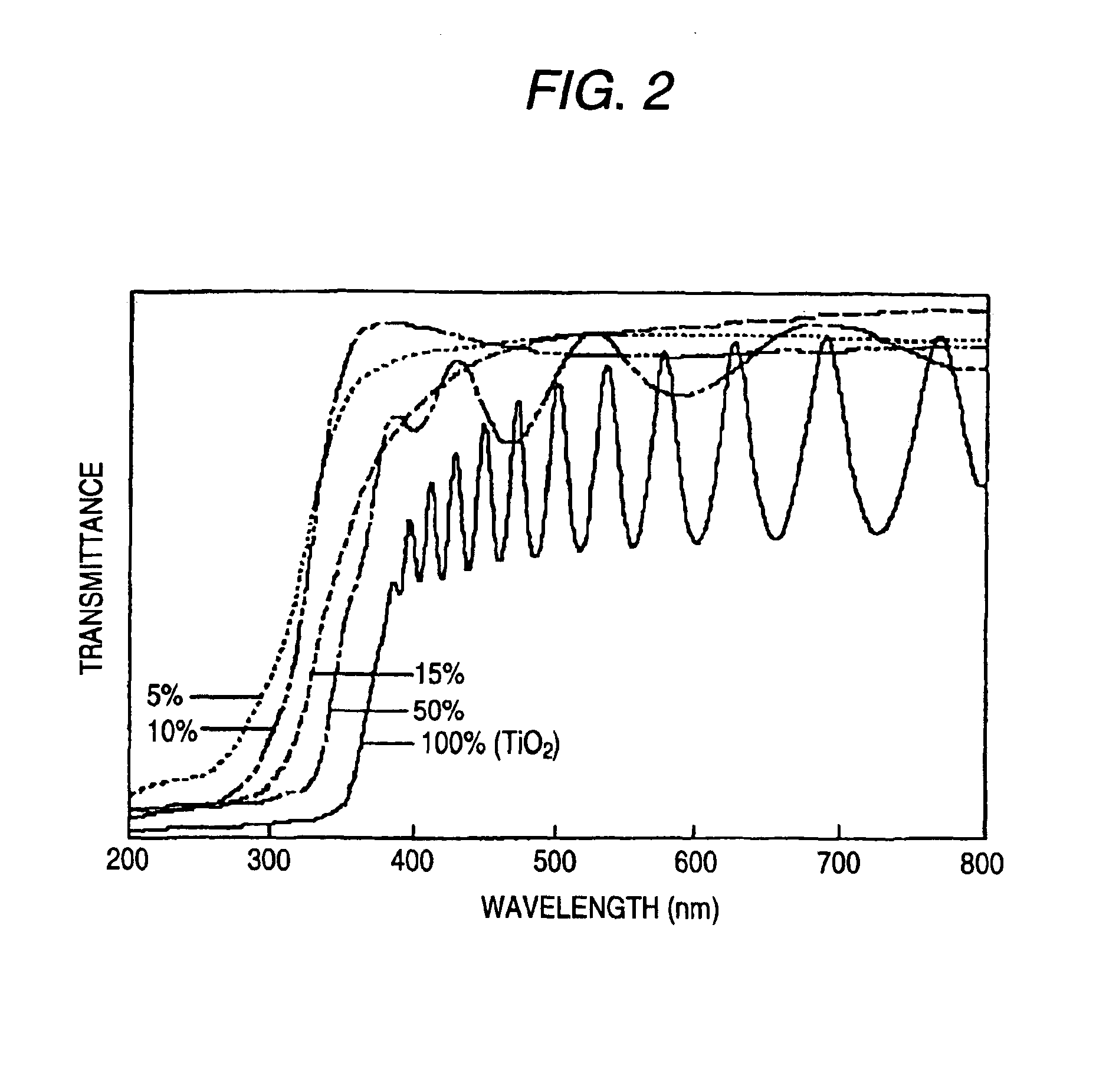Composite element and method for preparation thereof
- Summary
- Abstract
- Description
- Claims
- Application Information
AI Technical Summary
Benefits of technology
Problems solved by technology
Method used
Image
Examples
embodiment 1
(Embodiment 1)
FIG. 1 is a cross section showing a first embodiment of this invention. In FIG. 1, the thickness dimensions of a film are exaggerated in comparison with a real film, which is also applied to other embodiments. In a composite device 10, a base 12 is any of various substrates such as a glass substrate and a synthetic resin substrate. On the one surface of the base 12, a mixture film 14 is directly deposited to a thickness of, for example, about 0.1 to 1.0 μm. The mixture film 14 is a colorless and transparent film with a high light transmittance consisting of a mixture of boron oxide and photocatalytic titanium oxide, and the mixture film 14 forms the top surface of the composite device 10. In the composite device 10, the mixture film 14 is irradiated with ultraviolet rays to make the surface of the mixture film hydrophilic. Furthermore, if hydrophilicity is reduced due to adhesion of contaminants to the surface of the mixture film 14, photocatalytic effects of the photo...
embodiment 2
(Embodiment 2)
FIG. 7 is a cross section illustrating a second embodiment of this invention. The same symbols are used for parts / members common to embodiment 1. In the composite device 34, a base 12 is a substrate made of an appropriate material such as a glass substrate and a synthetic-resin substrate. On both surfaces of the base 12, mixture films 14, 36 are directly deposited to, for example, a thickness of about 0.1 to 1.0 μm, respectively. The mixture films 14, 36 are colorless and transparent mixture films with a high light transmittance consisting of a mixture of boron oxide and photocatalytic titanium oxide. These mixture films 14, 36 constitute the top surfaces of the composite device 34. In the composite device 34, the mixture films 14, 36 are irradiated with ultraviolet rays so that the surfaces of the mixture films 14, 36 are made hydrophilic. Furthermore, if hydrophilicity is reduced due to adhesion of contaminants to the surfaces of the mixture films 14, 36, photocataly...
embodiment 3
(Embodiment 3)
FIG. 8 is a cross section illustrating a third embodiment of this invention. The same symbols are used for parts / members common to embodiments 1 and 2. In the composite device 38, a base 12 is a substrate made of an appropriate material such as a glass substrate and a synthetic-resin substrate. On one surface of the base 12 is deposited an intermediate film 40, on which is then deposited a mixture film 14 to, for example, a thickness of about 0.1 to 1.0 μm. The mixture film 14 is a colorless and transparent mixture film with a high light transmittance consisting of a mixture of boron oxide and photocatalytic titanium oxide. The mixture film 14 constitutes the top surface of the composite device 38. When the base 12 is made of a soda-lime glass, the intermediate film 40 may be an alkali-diffusion inhibiting film such as a silica film which prevents alkali ions in the base 12 from diffusing into the mixture film 14. When the intermediate film 40 is a metal film made of, ...
PUM
| Property | Measurement | Unit |
|---|---|---|
| Fraction | aaaaa | aaaaa |
| Percent by mass | aaaaa | aaaaa |
| Transparency | aaaaa | aaaaa |
Abstract
Description
Claims
Application Information
 Login to View More
Login to View More - R&D
- Intellectual Property
- Life Sciences
- Materials
- Tech Scout
- Unparalleled Data Quality
- Higher Quality Content
- 60% Fewer Hallucinations
Browse by: Latest US Patents, China's latest patents, Technical Efficacy Thesaurus, Application Domain, Technology Topic, Popular Technical Reports.
© 2025 PatSnap. All rights reserved.Legal|Privacy policy|Modern Slavery Act Transparency Statement|Sitemap|About US| Contact US: help@patsnap.com



